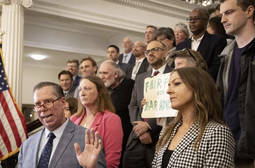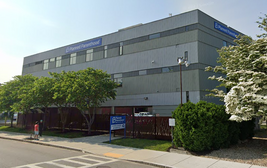Healey looks to cut environmental review time to boost housing production
 Photo | Courtesy of Commonwealth of Massachusetts
Massachusetts State House
Photo | Courtesy of Commonwealth of Massachusetts
Massachusetts State House
State officials are hoping to shrink the amount of time environmental review of housing projects takes from a year or more to just 30 days with a new set of regulations that Gov. Maura Healey called "a game changer."
Healey announced the draft regulations related to the Massachusetts Environmental Policy Act (MEPA) at a housing development underway in Medford on Tuesday. She said the draft rules, which are open for public comment until Oct. 31, are in line with the findings of the Unlocking Housing Production Commission that earlier this year said lengthy environmental reviews were delaying new housing developments for months and years, and were leading to higher and unexpected costs.
"It's our job to make sure government moves at the speed of business, and cutting these regulations will reduce review times from more than a year to 30 days and supercharge the building of homes across Massachusetts," Healey said.
For housing projects that meet certain criteria, the governor is proposing that the state no longer require a detailed Environmental Impact Report and instead allow developers to complete MEPA review with only "the simpler" Environmental Notification Form. The proposal would eliminate the automatic trigger of MEPA review for single-family homes in the event of an appeal of a local wetlands order, and would also reduce to a 30-day ENF filing the review of urban renewal plans that do not propose individual projects, the administration said.
Requirements for advance notice and community outreach will be maintained in the new rules to ensure transparency and engagement, the governor's office said.
"An EIR is a more detailed and costly analysis compared to an Environmental Notification Form (ENF), which is a preliminary review that typically involves less time and expense. An ENF typically takes 30-60 days where an EIR can take a minimum of nine to twelve months (and can cost anywhere from $350,000 to $1 million)," the governor's Unlocking Housing Production Commission wrote in the report it released in February. "Furthermore, this time and cost comes at a stage in the development process where the cost of capital is high, and other permits cannot be issued until the EIR is certified."
To qualify for the expedited environmental review, projects must comport with a slate of seven requirements. At least 67% of a project must be for a residential purpose; projects must meet certain unit-per-acre thresholds based on the types of housing; projects can only alter up to 5 acres of undeveloped land or up to 10 acres with the addition of a tree preservation and replanting plan; new developments must be built outside the current floodplain and redevelopment projects must build outside highest hazard areas; all projects must comply with the energy efficiency standards in the state's newer stretch energy code; development are required to limit the extent of new traffic; and there must be sufficient water supply, wastewater capacity and energy infrastructure to support the project.
The commission said the 2021 "climate roadmap" law signed by Gov. Charlie Baker redefined the term "environmental justice populations" and allowed for enhanced MEPA review of projects near those neighborhoods. Projects that trigger MEPA review within one mile of an environmental justice population (or within five miles in the case of air quality impacts) must submit an EIR. That requirement, the commission said, impacts "many projects that would not otherwise trigger an EIR if not for their proximity to an EJ community."
"Many multifamily housing projects that would have only required an ENF are now required to undergo lengthy EIR processes. In some instances, a multifamily developer may choose not to move forward with an otherwise viable project when EJ requirements mandate an EIR," the report said. "The added cost and time can render a project infeasible. The result is less housing production in areas where it is needed most."
At an event in Medford, Healey said the new regulations are about "cutting red tape so we can cut more ribbons on more new homes and get to more reasonably priced housing around this state."
The proposed regulations also strive to simplify the review process for certain ecological restoration projects, like cranberry bog restoration and partial dam removals, that the administration said have "important environmental benefits but do not qualify for existing streamlining." Healey's office said 23% of such projects that have filed with MEPA since 2022 would now only require an ENF.
"These changes will move critical housing projects from plans to reality much faster and will actually help us ensure that we’re incentivizing the kinds of housing we need the most – dense, energy efficient, and resilient buildings – while upholding our high environmental standards," Energy and Environmental Affairs Secretary Rebecca Tepper said.
The administration said the regulations proposed Tuesday "go beyond recent changes to environmental review processes in other states by allowing developers to qualify for quicker approvals while still addressing critical climate and environmental concerns."
"The proposed amended MEPA regulations are carefully designed to help the Commonwealth address a housing shortage and affordability crisis, while seeking to only affect the process of the existing environmental regulations, not the substance," Rafael Mares, executive director of the community development corporation The Neighborhood Developers, said. "We need a way to find ways to streamline permitting processes to boost housing production, while continuing to minimize environmental impacts. This is a step in that direction."
Healey's office also released statements of support for the regulations from officials at the Trustees of the Reservation and Conservation Law Foundation.
Massachusetts has dealt with chronic housing affordability and accessibility problems for years. The state is implementing a housing production law approved in August 2024, but officials have warned that it will take years to make a big dent in the housing shortage due to years of low construction rates, limits on the supply of buildable land and local zoning rules that inhibit production.
When she signed it in August 2024, Healey estimated the so-called Affordable Homes Act and related initiatives would support the production, preservation and rehabilitation of more than 65,000 homes over the next five years. Her administration has a goal of increasing the statewide supply of year-round housing by 222,000 units over the next decade, a 7% increase in supply.
In the first seven months of 2025, single-family home sales in Massachusetts were up 3.6% compared to the same period of 2024, according to The Warren Group, and the median single-family home sale price rose 3.4% year-over-year to stand at $640,000 year-to-date.













0 Comments